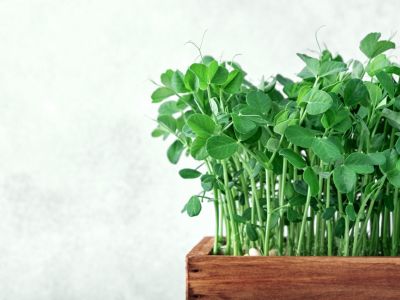Learning how to plant indoor vegetables creates a year-round, safe and environmentally-friendly food source with the added benefit of lowering grocery costs. To help you get started on this journey to self-sufficiency, here’s our list of the 10 best indoor vegetables to cultivate at home.
The 10 Best Indoor Vegetables
- Microgreens – When first learning how to plant indoor vegetables, consider growing microgreens. They are one of the easiest crops to cultivate and only take 2 to 4 weeks to reach a harvestable size. Microgreens require 4 to 6 hours of sunlight per day and can be grown using artificial light.
- Sprouts – Ready in about two weeks, sprouts are one of the quickest indoor vegetables you can grow. Purchase seed specifically designated for sprouts, as many garden seeds are treated with fungicides. Be sure to follow cultivation guidelines to avoid contamination by illness-causing pathogens.
- Salad greens – From leaf lettuce to arugula, salad greens are among the easiest indoor vegetables to grow. Ensure these plants have a minimum of 6 hours of sunlight per day and you’ll be harvesting leaves in about 4 to 8 weeks.
- Swiss Chard – Although quite adaptable to living in containers, Swiss Chard can mature at heights of 2 feet (61 cm.) and requires longer periods of light than either lettuce or microgreens. Grow a variety with brightly colored stalks and let this attractive plant do double duty as a decorative accent piece.
- Radishes – Another quick and easy indoor vegetable to grow, radishes mature in about 3 to 5 weeks. Use a container that’s at least 6 inches (15 cm.) deep, and avoid over-fertilizing to encourage proper root development.
- Carrots – This easily cultivated root crop requires about 6 hours of sunlight per day and a bit of patience. Depending upon variety, expect to wait about 65 to 80 days for harvestable roots. Plant carrots in a deep container or choose a ball-shaped variety like ‘Parisian.’
- Mushrooms – Ideal for low-light areas of the house, homegrown mushrooms are often tastier and available in more varieties than store-bought ones. Build your own setup or purchase a mushroom growing kit from a garden supply retailer.
- Cucumbers – To improve success rates when growing these indoor vegetables in pots, choose a cucumber variety like ‘Socrates’ or ‘Tyria.’ These hybrids were developed for greenhouse and high tunnel cultivation. They don’t require a pollinator and remain productive under lower light conditions.
- Peppers – As one of the more challenging indoor vegetables you can grow, peppers have specific light and darkness requirements and must be hand-pollinated in order to produce fruit. When indoor space is at a premium choose chile, dwarf or patio varieties of pepper plants.
- Tomatoes – Growing these indoor vegetables in pots can be tricky as tomato plants require 8 to 10 hours of direct sunlight per day and hand pollination. Varieties like ‘Micro Tom’ and ‘Orange Hat’ produce an abundance of fruit on miniature 6 to 9 inch (15 to 23 cm.) tall plants, which are small enough to sit on a window sill.
